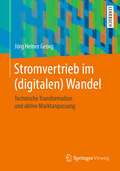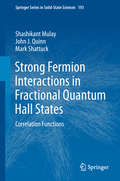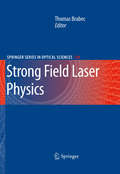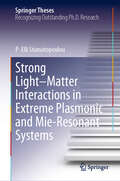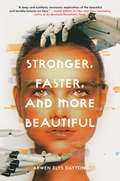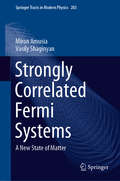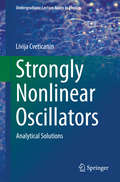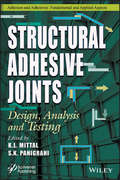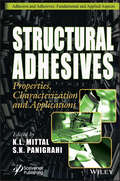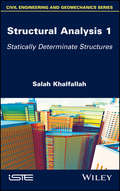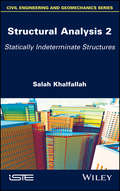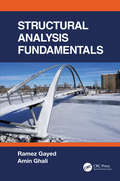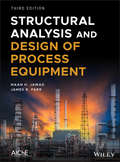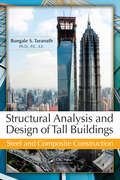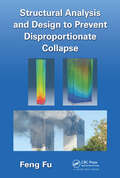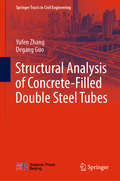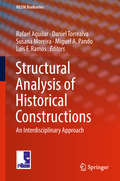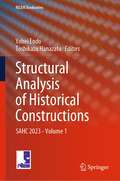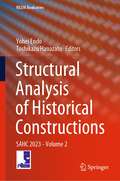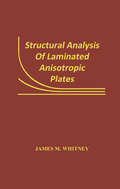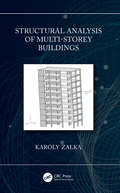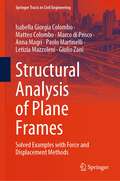- Table View
- List View
Stromvertrieb im (digitalen) Wandel: Technische Transformation und aktive Marktanpassung
by Jörg Heiner GeorgIn diesem Lehrbuch wird ein grundlegendes Verständnis für Geschäftsmodelle speziell im Stromvertrieb vermittelt und wesentliche Funktionen des Betriebsmodells (Aufbau- und Ablauforganisation) erklärt. Dabei hat der Autor auf auf Praxisbezug Wert gelegt und sowohl die Treiber der Digitalisierung als auch die Wirkungsmechanismen der Transformation sowie datengetriebene Geschäftsmodelle beschrieben. Architektur und systematischer Aufbau möglicher Geschäftsmodelle sind anhand von Teilmodellen nachvollziehbar dargestellt und veranschaulicht. Das Buch hilft Studierenden energietechnischer, energiewirtschaftlicher und angrenzender Fachbereiche aktuelle Modelle zu verstehen, zu analysieren und schafft damit die Grundvoraussetzung diese Kenntnisse im späteren Berufsleben einzusetzen.
Strong Fermion Interactions in Fractional Quantum Hall States: Correlation Functions (Springer Series In Solid-state Sciences Ser. #193)
by John J. Quinn Shashikant Mulay Mark ShattuckThis monograph presents an intuitive theory of trial wave functions for strongly interacting fermions in fractional quantum Hall states. The correlation functions for the proposed fermion interactions follow a novel algebraic approach that harnesses the classical theory of invariants and semi-invariants of binary forms. This approach can be viewed as a fitting and far-reaching generalization of Laughlin’s approach to trial wave functions. Aesthetically viewed, it illustrates an attractive symbiosis between the theory of invariants and the theory of correlations. Early research into numerical diagonalization computations for small numbers of electrons shows strong agreement with the constructed trial wave functions.The monograph offers researchers and students of condensed matter physics an accessible discussion of this interesting area of research.
Strong Field Laser Physics
by Thomas BrabecDue to the rapid progress in laser technology a wealth of novel fundamental and applied applications of lasers in atomic and plasma physics have become possible. This book focuses on the interaction of high intensity lasers with matter. It reviews the state of the art of high power laser sources, intensity laser-atom and laser-plasma interactions, laser matter interaction at relativistic intensities, and QED with intense lasers.
Strong Light–Matter Interactions in Extreme Plasmonic and Mie-Resonant Systems (Springer Theses)
by P. Elli StamatopoulouCollective excitations in matter, either in the form of plasmons in metals or Mie resonances in high-index dielectrics, constitute fundamental building blocks for photonic applications, including optical and quantum communications, biosensing, and polaritonic chemistry. Motivated by these prospects, this book explores excitations sustained in metallic and dielectric nanocavities and their interaction with light, quantum emitters, and swift electrons. The book presents analytic methods for describing the strong and weak coupling between spherical nanocavities and optical transitions in matter, while also analyzing the impact of nonlocality on the coupling, when considering extremely small metallic structures. Besides light-based spectroscopy, it examines electrons as sources for probing optical excitations in matter and provides analytic tools for simulating measurements in cathodoluminescence and electron energy-loss spectroscopy.
Strong-Coupling Theory of High-Temperature Superconductivity
by Alexandre S. AlexandrovHigh-temperature superconductivity has transformed the landscape of solid state science, leading to the discovery of new classes of materials, states of matter, and concepts. However, despite being over a quarter of a century since its discovery, there is still no single accepted theory to explain its origin. This book presents one approach, the strong-coupling or bipolaron theory, which proposes that high-temperature superconductivity originates from competing Coulomb and electron-phonon interactions. The author provides a thorough overview of the theory, describing numerous experimental observations, and giving detailed mathematical derivations of key theoretical findings at an accessible level. Applications of the theory to existing high-temperature superconductors are discussed, as well as possibilities of liquid superconductors and higher critical temperatures. Alternative theories are also examined to provide a balanced and informative perspective. This monograph will appeal to advanced researchers and academics in the fields of condensed matter physics and quantum-field theories.
Stronger, Faster, and More Beautiful
by Arwen Elys Dayton<P><P>For fans of television shows Black Mirror and Westworld, this compelling, mind-bending novel is a twisted look into the future, exploring the lengths we'll go to remake ourselves into the perfect human specimen and what it means to be human at all. <P><P>The future is curious. <P><P>STRONGER <P><P>Today our bodies define us. We color our hair; tattoo our skin; pierce our ears, brows, noses. We lift weights, run miles, break records. We are flesh and blood and bone. <P><P>FASTER <P><P>Tomorrow has different rules. The future is no longer about who we are--it's about who we want to be. If you can dream it, you can be it. Science will make us smarter, healthier, flawless in every way. Our future is boundless. <P><P>MORE BEAUTIFUL <P><P>This is a story that begins tomorrow. It's a story about us. It's a story about who comes after us. And it's a story about perfection. Because perfection has a way of getting ugly.
Strongly Correlated Fermi Systems: A New State of Matter (Springer Tracts in Modern Physics #283)
by Miron Amusia Vasily ShaginyanThis book focuses on the topological fermion condensation quantum phase transition (FCQPT), a phenomenon that reveals the complex behavior of all strongly correlated Fermi systems, such as heavy fermion metals, quantum spin liquids, quasicrystals, and two-dimensional systems, considering these as a new state of matter. The book combines theoretical evaluations with arguments based on experimental grounds demonstrating that the entirety of very different strongly correlated Fermi systems demonstrates a universal behavior induced by FCQPT. In contrast to the conventional quantum phase transition, whose physics in the quantum critical region are dominated by thermal or quantum fluctuations and characterized by the absence of quasiparticles, the physics of a Fermi system near FCQPT are controlled by a system of quasiparticles resembling the Landau quasiparticles. The book discusses the modification of strongly correlated systems under the action of FCQPT, representing the “missing” instability, which paves the way for developing an entirely new approach to condensed matter theory; and presents this physics as a new method for studying many-body objects. Based on the authors’ own theoretical investigations, as well as salient theoretical and experimental studies conducted by others, the book is well suited for both students and researchers in the field of condensed matter physics.
Strongly Nonlinear Oscillators
by Livija CveticaninThis book provides the presentation of the motion of pure nonlinear oscillatory systems and various solution procedures which give the approximate solutions of the strong nonlinear oscillator equations. The book presents the original author's method for the analytical solution procedure of the pure nonlinear oscillator system. After an introduction, the physical explanation of the pure nonlinearity and of the pure nonlinear oscillator is given. The analytical solution for free and forced vibrations of the one-degree-of-freedom strong nonlinear system with constant and time variable parameter is considered. Special attention is given to the one and two mass oscillatory systems with two-degrees-of-freedom. The criteria for the deterministic chaos in ideal and non-ideal pure nonlinear oscillators are derived analytically. The method for suppressing chaos is developed. Important problems are discussed in didactic exercises. The book is self-consistent and suitable as a textbook for students and also for professionals and engineers who apply these techniques to the field of nonlinear oscillations.
Structural Adhesive Joints: Design, Analysis, and Testing
by K. L. Mittal S. K. PanigrahiMost structures are comprised of a number of individual parts or components which have to be connected to form a system with integral load transmission path. The structural adhesive bonding represents one of the most enabling technologies to fabricate most complex structural configurations involving advanced materials (e.g. composites) for load-bearing applications. Quite recently there has been a lot of activity in harnessing nanotechnology (use of nanomaterials) in ameliorating the existing or devising better performing structural adhesives. The 10 chapters by subject matter experts look at the following issues: Surface preparation for structural adhesive joints (SAJ) Use of nanoparticles in enhancing performance of SAJ Optimization of SAJ Durability aspects of SAJ Debonding of SAJ Fracture mechanics of SAJ Failure analysis of SAJ Damage behavior in functionally graded SAJ Impact, shock and vibration characteristics of composites for SAJ Delamination arrest methods in SAJ
Structural Adhesives: Properties, Characterization and Applications
by K. L. Mittal S. K. PanigrahiStructural Adhesives Uniquely provides up-to-date and comprehensive information on the topic in an easily-accessible form. A structural adhesive can be described as a high-strength adhesive material that is isotropic in nature and bonds two or more parts together in a load-bearing structure. A structural adhesive material must be capable of transmitting the stress/load without loss of structural integrity within design limits. There are many types of established structural adhesives, including epoxy, urethane, acrylic, silicone, etc. Structural Adhesives comprises nine chapters and is divided into two parts: Part 1, Preparation, Properties, and Characterization; Part 2, Applications. The topics covered include: structural epoxy adhesives; biological reinforcement of epoxies as structural adhesives; marble dust reinforced epoxy structural adhesive composites; characterization of various structural adhesive materials; effects of shear and peel stress distributions on the behavior of structural adhesives; the inelastic response of structural aerospace adhesives; structural reactive acrylic adhesives: their preparation, characterization, properties, and applications; application of structural adhesives in composite connections; and naval applications of structural adhesives. Audience This book should be of much use and interest to adhesionists, materials scientists, adhesive technologists, polymer scientists, and those working in the construction, railway, automotive, aviation, bridge, and shipbuilding industries.
Structural Analysis
by Russell HibbelerStructural Analysis, 8e, provides readers with a clear and thorough presentation of the theory and application of structural analysis as it applies to trusses, beams, and frames. Emphasis is placed on teaching readers to both model and analyze a structure. Procedures for Analysis, Hibbeler's problem solving methodologies, provides readers with a logical, orderly method to follow when applying theory.
Structural Analysis 1: Statically Determinate Structures
by Salah KhalfallahUsing a general approach, this book supports the student to enable mastery of the methods of analysis of isostatic and hyperstatic structures. To show the performance of the methods of analysis of the hyperstatic structures, selected beams, gantries and reticular structures are selected and subjected to a comparative study by the different methods of analysis of the hyperstatic structures.
Structural Analysis 2: Statically Indeterminate Structures
by Salah KhalfallahThis book enables the student to master the methods of analysis of isostatic and hyperstatic structures. To show the performance of the methods of analysis of the hyperstatic structures, some beams, gantries and reticular structures are selected and subjected to a comparative study by the different methods of analysis of the hyperstatic structures. This procedure provides an insight into the methods of analysis of the structures.
Structural Analysis Fundamentals
by Amin Ghali Ramez GayedStructural Analysis Fundamentals presents fundamental procedures of structural analysis, necessary for teaching undergraduate and graduate courses and structural design practice. It applies linear analysis of structures of all types, including beams, plane and space trusses, plane and space frames, plane and eccentric grids, plates and shells, and assemblage of finite-elements. It also treats plastic and time-dependent responses of structures to static loading, as well as dynamic analysis of structures and their response to earthquakes. Geometric nonlinearity in analysis of cable nets and membranes are examined. This is an ideal text for basic and advanced material for use in undergraduate and higher courses. A companion set of computer programs assist in a thorough understanding and application of analysis procedures. The authors provide a special program for each structural system or each procedure. Unlike commercial software, the user can apply any program of the set without a manual or training period. Students, lecturers and engineers internationally employ the procedures presented in in this text and its companion website. Ramez B. Gayed is a Civil Engineering Consultant and Adjunct Professor at the University of Calgary. He is expert on analysis and design of concrete and steel structures. Amin Ghali is Emeritus Professor at the University of Calgary. He is consultant on major international structures. He is inventor of several reinforcing systems for concrete. He has authored over 300 papers and eight patents. His books include Concrete Structures (2012), Circular Storage Tanks and Silos (CRC Press, 2014), and Structural Analysis (CRC Press, 2017).
Structural Analysis and Design of Process Equipment
by James R. Farr Maan H. JawadStill the only book offering comprehensive coverage of the analysis and design of both API equipment and ASME pressure vessels This edition of the classic guide to the analysis and design of process equipment has been thoroughly updated to reflect current practices as well as the latest ASME Codes and API standards. In addition to covering the code requirements governing the design of process equipment, the book supplies structural, mechanical, and chemical engineers with expert guidance to the analysis and design of storage tanks, pressure vessels, boilers, heat exchangers, and related process equipment and its associated external and internal components. The use of process equipment, such as storage tanks, pressure vessels, and heat exchangers has expanded considerably over the last few decades in both the petroleum and chemical industries. The extremely high pressures and temperatures involved with the processes for which the equipment is designed makes it potentially very dangerous to property and life if the equipment is not designed and manufactured to an exacting standard. Accordingly, codes and standards such as the ASME and API were written to assure safety. Still the only guide covering the design of both API equipment and ASME pressure vessels, Structural Analysis and Design of Process Equipment, 3rd Edition: Covers the design of rectangular vessels with various side thicknesses and updated equations for the design of heat exchangers Now includes numerical vibration analysis needed for earthquake evaluation Relates the requirements of the ASME codes to international standards Describes, in detail, the background and assumptions made in deriving many design equations underpinning the ASME and API standards Includes methods for designing components that are not covered in either the API or ASME, including ring girders, leg supports, and internal components Contains procedures for calculating thermal stresses and discontinuity analysis of various components Structural Analysis and Design of Process Equipment, 3rd Edition is an indispensable tool-of-the-trade for mechanical engineers and chemical engineers working in the petroleum and chemical industries, manufacturing, as well as plant engineers in need of a reference for process equipment in power plants, petrochemical facilities, and nuclear facilities.
Structural Analysis and Design of Tall Buildings: Steel and Composite Construction
by Bungale S. TaranathAs software skills rise to the forefront of design concerns, the art of structural conceptualization is often minimized. Structural engineering, however, requires the marriage of artistic and intuitive designs with mathematical accuracy and detail. Computer analysis works to solidify and extend the creative idea or concept that might have started o
Structural Analysis and Design to Prevent Disproportionate Collapse
by Feng FuHard Guidance on Preventing Disproportionate CollapseDisproportionate collapse is a pressing issue in current design practice. Numerous causes are possible - especially forms of extreme loading, such as blast, fire, earthquake, or vehicle collisions. But it is the mechanism and its prevention which are of especial interest and concern.After the Wor
Structural Analysis of Concrete-Filled Double Steel Tubes (Springer Tracts in Civil Engineering)
by Yufen Zhang Degang GuoThis book offers a clear and comprehensive overview of both the theory and application of fundamental aspects of concrete-filled double steel tubes (CFDST). Many analysis and design applications are presented, which involve mechanical components and structural members often encountered in engineering practice. This monograph is written for practicing structural and civil engineers, students, and academic researchers who want to keep up to speed on the latest technologies for concrete-filled steel tube (CFST).
Structural Analysis of Historical Constructions: An Interdisciplinary Approach (Rilem Bookseries Ser. #18)
by Rafael Aguilar Daniel Torrealva Susana Moreira Miguel A. Pando Luis F. RamosThis volume contains the proceedings of the 11th International Conference on Structural Analysis of Historical Constructions (SAHC) that was held in Cusco, Peru in 2018. It disseminates recent advances in the areas related to the structural analysis of historical and archaeological constructions. The challenges faced in this field show that accuracy and robustness of results rely heavily on an interdisciplinary approach, where different areas of expertise from managers, practitioners, and scientists work together. Bearing this in mind, SAHC 2018 stimulated discussion on the new knowledge developed in the different disciplines involved in analysis, conservation, retrofit, and management of existing constructions. This book is organized according to the following topics: assessment and intervention of archaeological heritage, history of construction and building technology, advances in inspection and NDT, innovations in field and laboratory testing applied to historical construction and heritage, new technologies and techniques, risk and vulnerability assessments of heritage for multiple types of hazards, repair, strengthening, and retrofit of historical structures, numerical modeling and structural analysis, structural health monitoring, durability and sustainability, management and conservation strategies for heritage structures, and interdisciplinary projects and case studies. This volume holds particular interest for all the community interested in the challenging task of preserving existing constructions, enable great opportunities, and also uncover new challenges in the field of structural analysis of historical and archeological constructions.
Structural Analysis of Historical Constructions: SAHC 2023 - Volume 1 (RILEM Bookseries #47)
by Yohei Endo Toshikazu HanazatoThis book gathers the peer-reviewed papers presented at the 13th International Conference on Structural Analysis of Historical Constructions (SAHC), held in Kyoto, Japan, on September 12-15, 2023. It highlights the latest advances and innovations in the field of conservation and restoration of historical and heritage structures. The conference topics encompass history of construction and building technology, theory and practice of conservation, inspection methods, non-destructive techniques and laboratory testing, numerical modeling and structural analysis, management of heritage structures and conservation strategies, structural health monitoring, repair and strengthening strategies and techniques, vernacular constructions, seismic analysis and retrofit, vulnerability and risk analysis, resilience of historic areas to climate change and hazard events, durability, and sustainability. As such the book represents an invaluable, up-to-the-minute tool, providing an essential overview of conservation of historical constructions, and offers an important platform to engineers, architects, archeologists, and geophysicists.Chapter Guidelines for Seismic Retrofitting of Earthen Historic Buildings in Peru and Latin America is available open access under a Creative Commons Attribution 4.0 International License via link.springer.com.
Structural Analysis of Historical Constructions: SAHC 2023 - Volume 2 (RILEM Bookseries #46)
by Yohei Endo Toshikazu HanazatoThis book gathers the peer-reviewed papers presented at the 13th International Conference on Structural Analysis of Historical Constructions (SAHC), held in Kyoto, Japan, on September 12-15, 2023. It highlights the latest advances and innovations in the field of conservation and restoration of historical and heritage structures. The conference topics encompass history of construction and building technology, theory and practice of conservation, inspection methods, non-destructive techniques and laboratory testing, numerical modeling and structural analysis, management of heritage structures and conservation strategies, structural health monitoring, repair and strengthening strategies and techniques, vernacular constructions, seismic analysis and retrofit, vulnerability and risk analysis, resilience of historic areas to climate change and hazard events, durability, and sustainability. As such the book represents an invaluable, up-to-the-minute tool, providing an essential overview of conservation of historical constructions, and offers an important platform to engineers, architects, archeologists, and geophysicists.Chapter The Challenges of the Conservation of Earthen Sites in Seismic Areas, Chapter Performance Evaluation of Patch Repairs on Historic Concrete Structures (PEPS): Preliminary Results from Two English Case Studies are available open access under a Creative Commons Attribution 4.0 International License via link.springer.com.
Structural Analysis of Laminated Anisotropic Plates
by James M. WhitneyA major basic text on the theory and structural applications of laminated anisotropic plates. Detailed coverage of problems of bending under transverse load, stability, and free-vibrations, as well as laminated beams, expansional strain effects, curved plates, and free-edge effects.
Structural Analysis of Metallic Glasses with Computational Homology
by Akihiko Hirata Kaname Matsue Mingwei ChenThis book introduces the application of computational homology for structural analysis of metallic glasses. Metallic glasses, relatively new materials in the field of metals, are the next-generation structural and functional materials owing to their excellent properties. To understand their properties and to develop novel metallic glass materials, it is necessary to uncover their atomic structures which have no periodicity, unlike crystals. Although many experimental and simulation studies have been performed to reveal the structures, it is extremely difficult to perceive a relationship between structures and properties without an appropriate point of view, or language. The purpose here is to show how a new approach using computational homology gives a useful insight into the interpretation of atomic structures. It is noted that computational homology has rapidly developed and is now widely applied for various data analyses. The book begins with a brief basic survey of metallic glasses and computational homology, then goes on to the detailed procedures and interpretation of computational homology analysis for metallic glasses. Understandable and readable information for both materials scientists and mathematicians is also provided.
Structural Analysis of Multi-Storey Buildings
by Karoly A. ZalkaThe structural analysis of multi-storey buildings can be carried out using discrete (computer-based) models or creating continuum models that lead to much simpler albeit normally approximate results. The book relies on the second approach and presents the theoretical background and the governing differential equations (for researchers) and simple closed-form solutions (for practicing structural engineers). The continuum models also help to understand how the stiffness and geometrical characteristics influence the three-dimensional behaviour of complex bracing systems. The back-of-the-envelop formulae for the maximum deflection and rotation, load shares, fundamental frequency and critical load facilitate quick global structural analysis for even large buildings. It is shown how the global critical load ratio can be used for monitoring the "health" of the structure acting as a performance indicator and "safety factor". Evaluating the results of over sixteen hundred calculations, the accuracy of the procedures is comprehensively demonstrated by comparing the discrete and continuum results. Nineteen worked examples illustrate the use of the methods, whose downloadable MathCad and Excel worksheets (www.crcpress.com/ 9780367350253) can also be used as templates for similar practical situations.
Structural Analysis of Plane Frames: Solved Examples with Force and Displacement Methods (Springer Tracts in Civil Engineering)
by Matteo Colombo Marco di Prisco Isabella Giorgia Colombo Anna Magri Paolo Martinelli Letizia Mazzoleni Giulio ZaniThis textbook presents applicative examples of the main methods of structural analysis of statically indeterminate frame structures. It begins with a brief description of the kinematic analysis for plane frames. The Force Method, the Displacement Method and the Mixed method are applied for the solutions of statically indeterminate plane structures. The book first deals with the solution of simple reference cases where the most common structural situations, such as inclined rods, extensional and rotational springs, thermal variations, symmetry and anti-symmetry (just to mention some of them) are treated singularly. It then reports the complete solution of complex plane frames where the most common structural situations, individually analyzed in the previous chapter, are combined.Given the diverse and wide range of examples covered, the volume represents an ideal learning resource for students of Civil and Building Engineering and Architecture, and a valuable reference guide for structural engineering professionals.
